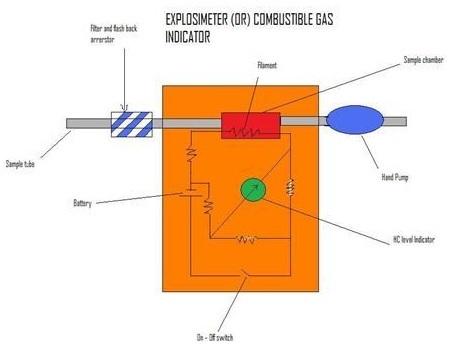Use & Limitations of Explosimeter on Oil Tankers:
It is used for the detection and measurement of combustible gases and vapour. It depends for its operation on the heat developed by the actual combustion of the flammable portion of the sample. The sample is drawn over a heated filament which forms one arm of a balanced Wheatstone’s bridge circuit.
The current for the circuit is provided by six standard dry cells. Combustible gas in the sample is burnt on the filament. Thus its temperature is raised and its resistance increases in proportion to the amount of combustible gas burnt i.e. in proportion to the amount of combustible gas in the sample. The circuit is now unbalanced which causes a deflection of the meter. The scale is graduated in percentage of the lower explosive limit. The scale is graduated in percentage of the lower explosive limit. The initial balance of the circuit is achieved in fresh air with the meter at zero by adjustment of a rheostat R, in the figure.

The Limitations of the Explosimeter are:-
- As the explosimeter only indicates the presence of flammable gases and vapours it may be dangerous to enter the compartment as no indication of toxicity is given or sufficiency of oxygen.
- A compartment which is initially safe may be rendered unsafe by future operations e.g. stirring or handling bottom sludge in a crude oil tank. Hence, frequent tests are required while the work in progress.
- If a compartment having a high boiling point liquid is heated by welding or other processes the vapour concentration will increase and such an atmosphere which originally showed a low concentration vapour may now be rendered explosive.
- When testing at a high temperature some of the vapour may condense in the sampling tube of the instrument, so only a small concentrate of vapour will be indicated by the instrument.
- As the instrument depends on combustion of the flammable portion of the sample it cannot detect in a steam or inert atmosphere due to the absence of O2. In the case of inerted tanks of vessels carrying crude or refined petroleum products an instrument called a tankscope has been specially designed to detect and measure the concentration of hydro carbon vapour in the absence of oxygen.
Use & Limitations of Tank Scope on Oil Tankers:
Diagram same as Explosimeter
- This is used to detect the presence of a variety of toxic gases inside the compartment.
- They work on the principle of chemical absorption of the gas to be detected by a re-agent which gets discoloured.
- A sample of the atmosphere is drawn into a tube containing crystals of the reagent.
- The tube is graduated and the level of discolouration indicates the concentration of the vapour in the sample.
- The amount of air drawn through the tube must be exactly the same each time to ensure this the bellows must be fully compressed and allowed to expand to the full limit of the limiter chain.
- The tubes have a shelf life of two years. Both ends of the tube are broken before use and one end is fitted into the pump head.
- Different tubes are used for detection of different gases.
-
 2nd Mate (F.G.) & NCV (NWKO) – Volume 3 (Cargo)₹ 219.00
2nd Mate (F.G.) & NCV (NWKO) – Volume 3 (Cargo)₹ 219.00 -
 Cargo Consolidated Notes for Phase 1 Chief Mate₹ 361.00
Cargo Consolidated Notes for Phase 1 Chief Mate₹ 361.00 -
 Cargo Solved MMD Past Papers Phase 1 Chief MatePrice range: ₹ 244.00 through ₹ 576.00
Cargo Solved MMD Past Papers Phase 1 Chief MatePrice range: ₹ 244.00 through ₹ 576.00